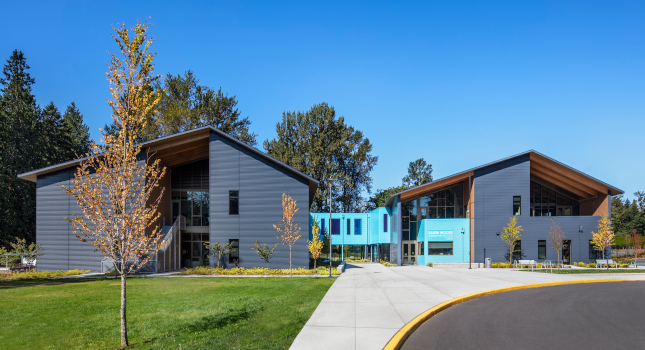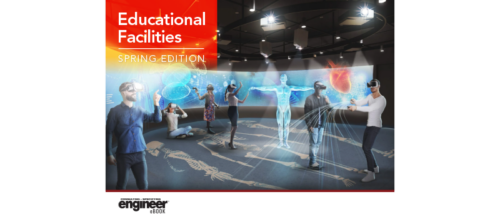K-12 roundtable focuses on advanced technologies
HVAC and security systems are being upgraded at K-12 schools
K-12 school insights
- After COVID-19, many K-12 school buildings were upgraded to improve their indoor environmental quality.
- Technology and new learning techniques are changing the way engineers design systems within K-12 schools.

Misty DuPré, PE, Principal, Salas O’Brien, Vista, California – Maureen McDonald, LEED AP, Director, Energy Services, Southland Industries, Garden Grove, California – Steven Mrak, PE, Vice President, Peter Basso Associates Inc., Troy, Michigan – Steve Reigh, PE, HBDP, Engineering Leader, DLR Group, Washington, D.C.
Participants:
- Misty DuPré, PE, Principal, Salas O’Brien, Vista, California
- Maureen McDonald, LEED AP, Director, Energy Services, Southland Industries, Garden Grove, California
- Steven Mrak, PE, Vice President, Peter Basso Associates Inc., Troy, Michigan
- Steve Reigh, PE, HBDP, Engineering Leader, DLR Group, Washington, D.C.
What are the current trends in K-12 school projects?
Misty DuPré: We see quite a few trends relating to safety and security, advanced technology and hygiene within new designs of K-12 school sites and classroom settings.
As a result of recent events, campus security is on the forefront of changing designs. Ensuring campuses have full perimeter fencing, secured man gates, monitored security and the ability to do automated lock-down is a priority. We are also seeing more provisions for mass notification and public address features such as rolling alert screens and the like. This safety trend is also extending beyond the school to lighted crosswalks. These are activated by a sensor or push-button with visual and/or audible signals to alert both pedestrians and drivers that crossing will occur.
Related to health safety and hygiene, plumbing fixtures are trending to be touch-free. Sensor-activated lavatories, toilet flush valves and automatic hand dryers are becoming the standard. Additionally, with the health concerns about youth and ecigarettes, vape sensors are being added to student restrooms. These sensors are triggered by the effluents given off by ecigarettes and send a signal to either the building management system or front desk for administrator attention.
Technology provisions are continuously improving, from the classroom setting to the maintenance personnel. With current funding limitations and staffing shortages, maintenance personnel are being stretched very thin. Multiple campus sites are being maintained by minimal staff. An increasing number of school sites are being equipped with BMS to aid in timeliness of ongoing maintenance requirements as well as monitoring systems’ functionality. BMS allow for scheduling regular maintenance activities to ensure preventative measures are being addressed before bigger, costlier issues occur. Many utility companies are also participating in demand response activities where having a BMS can allow school sites to quickly adjust their operation to respond to high peak load situations.
In the classroom, projectors and smart boards are quickly being replaced with large, 72-inch touch-screen interactive monitors to support more effective and engaging teaching methods.
Maureen McDonald: Current trends in K–12 projects include upgrading HVAC and controls, adding HVAC to coastal area schools, adding HVAC to gyms and auditoriums, increasing focus on indoor air quality and monitoring, increasing use of technology, accommodating changes in class size, focusing on energy management tied to sustainability and greenhouse gas reductions and highlighting public-private partnerships as a financing mechanism.
Steven Mrak: Recently, Peter Basso Associates have seen a resurgence in vocational training education spaces. As more school districts support the notion that college or university may not be the next step for all graduates, these vocational curriculums include welding/metal shops, construction trades, robotics, nursing/emergency medical technician and more. The occupation specific education and training allows students to potentially step right into a fulfilling career straight from high school. These types of spaces can become very mechanical, electrical and plumbing engineering intense from an infrastructure standpoint. In addition, living in the post-pandemic world, K-12 schools have seen a renewed focus on the importance of IAQ. Upgraded ventilation systems and filtration are top of mind now for our clients.
Steve Reigh: We are seeing an increased focus on energy efficiency and indoor environment quality. Districts want to spend less money on their energy bills and provide better environments for their occupants. COVID-19 has brought IEQ to the forefront of discussions when selecting systems for buildings. ASHRAE has released resources for bettering buildings to help both engineers and building owners understand best practices for good IEQ moving forward.

At the Salem Woods Elementary School, a heat recovery air to water chiller system was incorporated. Courtesy: DLR Group
What future trends should engineers expect?
Misty DuPré: As funding becomes available, schools will continue to invest in safety and security, hygiene and technology.
Maureen McDonald: Engineers should expect continued push for increased efficiency of HVAC, improved monitoring for IAQ, flexibility in HVAC systems to accommodate class size changes, increased interest in use of natural gas versus electricity, interest in HVAC technologies that reduce greenhouse gas emissions and increased focus on overall sustainability and the effect of operations on climate change.
Steven Mrak: Decarbonization, carbon neutral, net zero, zero energy — all have different definitions and different levels of importance to today’s K-12 school district facility directors. As the districts balance their priorities, newer mechanical technologies (or maybe just newer to the K-12 market) can be designed around to meet individual district needs. Extended range air-to-air heat pumps using carbon dioxide as refrigerant may be useful as a district looks to decarbonize in northern climates. In conjunction, as photovoltaic panel costs continue to decrease, return on investment improves and northern installations become more practical.
Steve Reigh: The application of energy codes pushing lower and lower energy requirements is pushing engineers to fully decouple ventilation air from heating and cooling energy. This is a direct attack on unnecessarily spent fan energy, which can be a quite large component of the energy consumption pie chart of a building’s total energy usage. If this type of system is used in conjunction with a displacement ventilation type system, it has the added benefit of great IAQ, which has been of great concern for schools the last 10 to 15 years.
What are engineers doing to ensure such projects (both new and existing structures) meet challenges associated with emerging technologies?
Misty DuPré: Whenever we take on a new project, we evaluate what capabilities exist within the existing infrastructure. If the age and operating condition are such that recommending system replacement is the only reasonable approach, there is opportunity to integrate the new and emerging technologies. Making economical choices in school design is crucial to help those limited funds stretch to cover as much as possible.
Tell us about a recent project you’ve worked on that’s innovative, largescale or otherwise noteworthy.
Misty DuPré: One project we were recently involved in is the new science, technology, engineering and math classroom building at Aliso Niguel High School. This modern, two-story design incorporated open space, natural lighting and exposed structural elements to highlight the engineered systems within the building. By design, students are able to see how the cabling, ductwork and piping are running throughout the building, making the technology they are learning about come more to life. Some key elements to the design included acid waste piping from laboratories, fume hood exhaust and daylight harvesting.
Maureen McDonald: Our recent Pomona Unified School District project located in Pomona, California, includes upgrading HVAC at 20 schools. Due to different conditions at each site, the HVAC technologies being employed include single-zone gas packs, single-zone split systems with gas heat, multizone air handling units, single-zone heat pumps, electric heat pumps, direct expansion split systems, mini splits, air cooled chillers and condensers, ductless split systems, cooling towers and boilers. Because a lot of the previous HVAC equipment is end-of-life, the schedule has been flexible to address premature failures. Additionally, due to the deadlines associated with COVID-19 relief funding and the supply change challenges, work has had to be flexibly scheduled around school sessions. Regarding safety, there have been zero safety incidents recorded on this project.
Steven Mrak: A joint venture between the Marygrove Conservancy, University of Michigan – School of Education, Detroit Public School Community District, Starfish Family Services and IFF, the Marygrove Early Education Center in Detroit established a critical piece of the overall P-20 cradle-to-career campus transformation. Ranging from six weeks old up to 5 years old, the students of the early education center represent a diverse student community within a diverse Marygrove campus community. Mechanically, the building is served by a vertical geo-exchange field, dedicated outdoor air system with energy recovery and efficient water-to-air heat pumps. A water-to-water heat pump provides low temperature heating water to radiant floor systems throughout each classroom.
Steve Reigh: A recent school in Monroe, Washington, that finished construction right as the pandemic started used an enhanced envelope, displacement ventilation, high-efficiency filtration, 100% outside air with energy recovery and an air source heat recovery heat pump to reduce the energy consumption of the classroom building while providing great IEQ to the facility. The project cost estimate came in 15% over budget at the end of design development and the integrated design team of all disciplines in-house at DLR Group put their heads together to find creative ways to reduce costs without sacrificing the IEQ and energy goals of the overall team. Everybody sharpened their pencils and gave a little equally to allow the project bid to come in at exactly the budget and retained all of the originally proposed energy conservation measures.
How are engineers designing these kinds of projects to keep costs down while offering appealing features, complying with relevant codes and meeting client needs?
Misty DuPré: With supply chain issues and factory production lead times driving costs up, a current focus is on making use of standard off-the-shelf items to help keep project schedules on track.
As classroom needs change and as viruses and pandemics evolve, how are you adapting learning environments for different uses and learning styles?
Maureen McDonald: Schools are looking for outdoor learning areas, decreasing class sizes, monitoring IAQ at the classroom level and upgrading HVAC and controls.
Steven Mrak: IAQ has been front and center in our designs, especially since the COVID-19 pandemic. A higher awareness of total air changes per hour and how that relates to higher-efficiency filtration systems. Prepandemic, it was common for schools to use MERV 8 filters on standard classroom unit ventilators due to cost and frequency of require service. Post-pandemic, we have seen a renewed interest from districts to employ higher MERV rated filters, which sometimes require rebalancing of systems or fan motor upgrades. Also, implementing a control strategy that includes a pre and post-occupancy purge of student spaces provides a higher level of IAQ.
Do you have experience and expertise with the topics mentioned in this content? You should consider contributing to our CFE Media editorial team and getting the recognition you and your company deserve. Click here to start this process.



